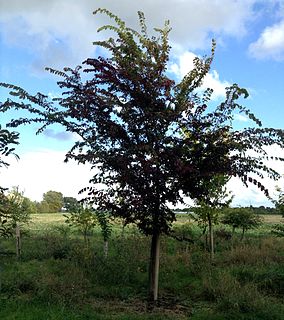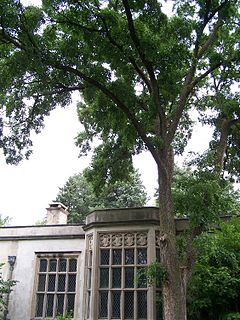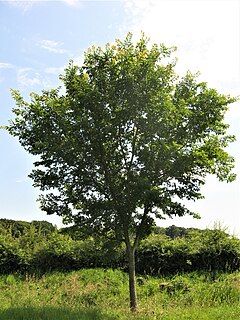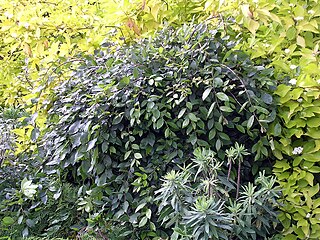
Ulmus americana, generally known as the American elm or, less commonly, as the white elm or water elm, is a species of elm native to eastern North America, naturally occurring from Nova Scotia west to Alberta and Montana, and south to Florida and central Texas. The American elm is an extremely hardy tree that can withstand winter temperatures as low as −42 °C. Trees in areas unaffected by Dutch elm disease (DED) can live for several hundred years. A prime example of the species was the Sauble Elm, which grew beside the banks of the Sauble River in Ontario, Canada, to a height of 43 m (140 ft), with a d.b.h of 196 cm (6.43 ft) before succumbing to DED; when it was felled in 1968, a tree-ring count established that it had germinated in 1701.

The Wych Elm cultivar Ulmus glabra 'Camperdownii', commonly known as the Camperdown Elm, was discovered about 1835–1840 as a young contorted elm growing in the forest at Camperdown House, in Dundee, Scotland, by the Earl of Camperdown's head forester, David Taylor. The young tree was lifted and replanted within the gardens of Camperdown House where it remains to this day. The original tree, which grows on its own roots, is less than 3 m tall, with a weeping habit and contorted branch structure. The earl's gardener is said to have produced the first of what are commonly recognised as Camperdown elms by grafting a cutting to the trunk of a wych elm.

Ulmus rubra, the slippery elm, is a species of elm native to eastern North America. Other common names include red elm, gray elm, soft elm, moose elm, and Indian elm.

Ulmus wallichianaPlanch., the Himalayan elm, also known as the Kashmir elm and Bhutan elm, is a mountain tree ranging from central Nuristan in Afghanistan, through northern Pakistan and northern India to western Nepal at elevations of 800–3000 m. Although dissimilar in appearance, its common name is occasionally used in error for the cherry bark elm Ulmus villosa, which is also endemic to the Kashmir, but inhabits the valleys, not the mountain slopes. The species is closely related to the wych elm U. glabra.

Ulmus × hollandica 'Vegeta', sometimes known as the Huntingdon Elm, is an old English hybrid cultivar raised at Brampton, near Huntingdon, by nurserymen Wood & Ingram in 1746, allegedly from seed collected at nearby Hinchingbrooke Park. In Augustine Henry's day, in the later 19th century, the elms in Hinchingbrooke Park were U. nitens. Richens, noting that wych elm is rare in Huntingdonshire, normally flowering four to six weeks later than field elm, pointed out that unusually favourable circumstances would have had to coincide to produce such seed: "It is possible that, some time in the eighteenth century, the threefold requirements of synchronous flowering of the two species, a south-west wind", "and a mild spring permitting the ripening of the samaras, were met."

The Field Elm cultivar Ulmus minor 'Sarniensis', known variously as Guernsey Elm, Jersey Elm, Wheatley Elm, or Southampton Elm, was first described by MacCulloch in 1815 from trees on Guernsey, and was planted in the Royal Horticultural Society's gardens in the 1820s. It was listed in the Loddiges catalogue of 1836 as Ulmus sarniensis and by Loudon in Hortus lignosus londinensis (1838) as U. campestris var. sarniensis. The origin of the tree remains obscure; Richens believed it "a mutant of a French population of Field elm", noting that "elms of similar leaf-form occur in Cotentin and in northern Brittany. They vary much in habit but some have a tendency to pyramidal growth. Whether the distinctive habit first developed on the mainland or in Guernsey is uncertain."

Ulmus 'Frontier' is an American hybrid cultivar, a United States National Arboretum introduction derived from a crossing of the European Field Elm Ulmus minor with the Chinese Elm Ulmus parvifolia in 1971. Released in 1990, the tree is a rare example of the hybridization of spring- and autumn-flowering elms. Tested in the US National Elm Trial coordinated by Colorado State University, 'Frontier' averaged a survival rate of 74% after 10 years.

The hybrid cultivar Ulmus × hollandica 'Cicestria', commonly known as the 'Chichester Elm', was cloned at the beginning of the 18th century from a tree growing at Chichester Hall, Rawreth, near Danbury, Essex, England, then the home of Thomas Holt White FRS, brother of the naturalist Gilbert White. The tree was first recorded by country parson and botanist Adam Buddle in south-east Essex in 1711, and appeared as U. cicestria in an 1801 catalogue. 'Cicestria' is the original Ulmus × hollandica 'Vegeta', but suffered confusion with the later Huntingdon Elm cultivar by John Claudius Loudon who, without consulting Lindley, accorded the epithet 'Vegeta' to Huntingdon Elm in 1838, as he found the two indistinguishable. J. E. Little in The Journal of Botany (1923) agreed that Buddle's leaves-specimen of Chichester Elm in the Sloane Herbarium seemed to be the same cultivar as Huntingdon Elm: "If so, this elm [Chichester] was in existence and mature some years before the reputed raising of the Huntingdon Elm by Wood of Huntingdon 'about 1746'."

Ulmus 'Morton' is an elm cultivar cloned from a putative intraspecific hybrid planted at the Morton Arboretum in 1924, which itself originated as seed collected from a tree at the Arnold Arboretum in Massachusetts. Although this tree was originally identified as Ulmus crassifolia, it is now believed to have been a hybrid of the Japanese elm and Wilson's elm. Accolade has proven to be the most successful cultivar tested in the US National Elm Trial, averaging a survival rate of 92.5% overall.

Ulmus 'Morton Glossy' is a hybrid cultivar raised by the Morton Arboretum, Illinois. Originally named 'Charisma' until it was realized that name had already been registered for another plant, the tree was derived from a crossing of two other hybrid cultivars grown at the Morton: Accolade and Vanguard. Tested in the US National Elm Trial coordinated by Colorado State University, Triumph averaged a survival rate of 86% after 10 years. Triumph was introduced to the UK in 2006 by the Frank P. Matthews nursery in Worcestershire.

Ulmus 'Morton Red Tip' is a hybrid cultivar raised by the Morton Arboretum from an open pollination of Ulmus 'Morton'. The tree has occasionally been reported as a hybrid of Accolade with the Siberian Elm Ulmus pumila, an error probably owing to the commercial propagation of the tree by grafting onto U. pumila rootstocks. Tested in the US National Elm Trial coordinated by Colorado State University, Danada Charm averaged a survival rate of 77.5% after 10 years.

The Wych Elm cultivar Ulmus glabra 'Horizontalis', commonly known as the Weeping Wych Elm or Horizontal Elm, was discovered in a Perth nursery circa 1816. The tree was originally identified as 'Pendula' by Loddiges (London), in his catalogue of 1836, a name adopted by Loudon two years later in Arboretum et Fruticetum Britannicum, 3: 1398, 1838, but later sunk as a synonym for 'Horizontalis'.

The Field Elm cultivar Ulmus minor 'Christine Buisman' was the first cultivar released by the Dutch elm breeding programme, initiated in response to the less virulent form of Dutch elm disease (DED), Ophiostoma ulmi, which afflicted Europe's elms after the First World War. 'Christine Buisman' was selected from a batch of 390 seedlings grown from seed collected in the Parque de la Quinta de la Fuente del Berro, Madrid, by Mrs Van Eeghen, a friend of elm researcher Johanna Westerdijk, in 1929 and named for the elm disease researcher Christine Buisman. Originally identified as Ulmus foliacea, it was later treated as Ulmus × hollandica by Melville. However, more recent research in Belgium using DNA markers has reaffirmed 'Christine Buisman' as a clone of U. minor.

The Wych Elm cultivar Ulmus glabra 'Cornuta', in cultivation before 1845 – Fontaine (1968) gives its provenance as France, 1835 – is a little-known tree, finally identified as a cultivar of U. glabra by Boom in Nederlandse Dendrologie 1: 157, 1959.

Ulmus 'Patriot' is a hybrid cultivar raised by the United States National Arboretum in 1980. Derived from a crossing of the American hybrid 'Urban' with the Wilson's Elm cultivar 'Prospector', 'Patriot' was released to commerce, free of patent restrictions, in 1993. Tested in the US National Elm Trial coordinated by Colorado State University, 'Patriot' averaged a survival rate of 85% after 10 years.

The winged elm cultivar Ulmus alata 'Lace Parasol' was found by a North Carolina nurseryman growing in local woods. Removed to his yard, it remained there until his death, when it was removed again to the North Carolina State Arboretum in Raleigh by J. C. Raulston.

The American elm cultivar Ulmus americana 'Beebe's Weeping' was propagated from a tree growing in the wild at Galena, Illinois, by Mr. E. Beebe circa 1889. It was marketed by the Klehm nursery of Arlington Heights, Illinois, in the early 20th century, as Ulmus 'American Galena Weeping', "American Weeping Elm".
The elm cultivar Ulmus 'Myrtifolia', the Myrtle-leaved Elm, first appeared in nursery and horticultural lists from the 1830s, as Ulmus myrtifolia and Ulmus campestris myrtifolia, the name Ulmus myrtifoliaVolxem being used at Kew Gardens from 1880. Lawson's nursery of Edinburgh appears to have been the earliest to list the tree. 'Myrtifolia' was listed by Nicholson in Kew Hand-List Trees & Shrubs (1896), but without description. It was later listed as a cultivar and described by Rehder in 1939 and by Krüssmann in 1962.

The hybrid cultivar Ulmus 'Androssowii'R. Kam., an elm of Uzbekistan sometimes referred to in old travel books as 'Turkestan Elm' or as 'karagach' [:black tree, = elm], its local name, is probably an artificial hybrid. According to Lozina-Lozinskaia the tree is unknown in the wild in Uzbekistan, and apparently arose from a crossing of U. densa var. bubyrianaLitv., which it resembles, and the Siberian Elm Ulmus pumila.

The 'dwarf' elm cultivar Ulmus 'Jacqueline Hillier' ('JH') is an elm of uncertain origin. It was cloned from a specimen found in a private garden in Selly Park, Birmingham, England, in 1966. The garden's owner told Hillier that it might have been introduced from outside the country by a relative. Hillier at first conjectured U. minor, as did Heybroek (2009). Identical-looking elm cultivars in Russia are labelled forms of Siberian Elm, Ulmus pumila, which is known to produce 'JH'-type long shoots. Melville considered 'JH' a hybrid cultivar from the 'Elegantissima' group of Ulmus × hollandica. Uncertainty about its parentage has led most nurserymen to list the tree simply as Ulmus 'Jacqueline Hillier'. 'JH' is not known to produce flowers and samarae, or root suckers.




















